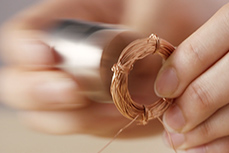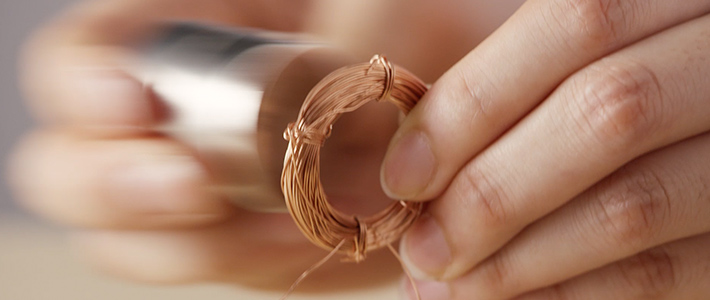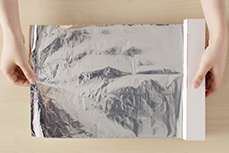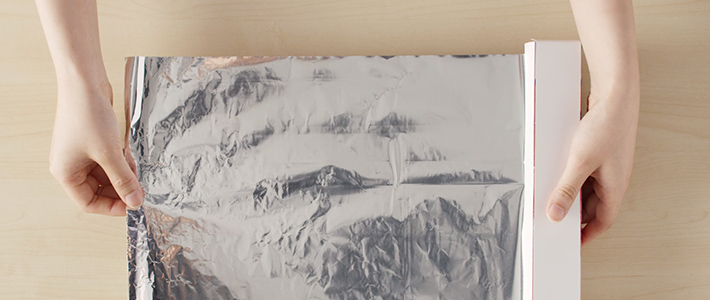Electric current is the transition of electrons from one place to another. When electrons transit (when electric current flows), a magnetic field is generated in the surrounding area. Let’s perform a simple experiment that examines electric current flow, magnetic fields, magnetic force, and how they interact.






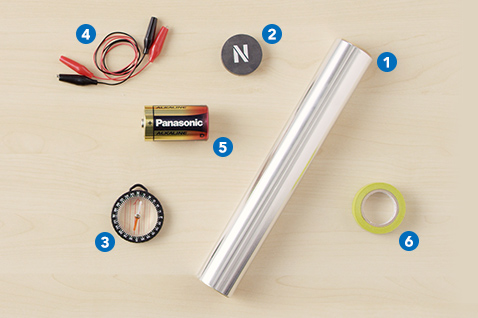
Materials/Tools you’ll need
 Aluminum foil
Aluminum foil
 1 x two-sided magnet with north/south polarities
1 x two-sided magnet with north/south polarities
 1 x compass (use an inexpensive one as it may be damaged)
1 x compass (use an inexpensive one as it may be damaged)
 2 x alligator-clip wires
2 x alligator-clip wires
 1 x dry battery (D-size battery preferred as it resists heat generation, though C- and AA-size batteries may also be used for shorter periods)
1 x dry battery (D-size battery preferred as it resists heat generation, though C- and AA-size batteries may also be used for shorter periods)
 Adhesive cello-tape or similar
Adhesive cello-tape or similar
・Scissors
・Ruler

Cut a strip of aluminum foil about 1 cm wide. This strip of metallic material will be used to conduct a flow of electrons.

If you cut the strip of aluminum foil too wide, the results of our experiment will be more difficult to detect. The ideal width is between 1.0–1.5 cm. Use a ruler to measure if you need to.

Bend your strip of aluminum foil into an arched “Ω” shape, and then secure the feet of your arch to the desk with adhesive tape. Leave a few centimeters of foil sticking out past the taped area—we will need those in the next step.

Attach alligator-clip wires onto the ends of your foil strip. Then position a compass beneath the center of the arch.

Touch the end of one wire to the battery’s positive terminal. Then touch the end of the other wire to the negative battery terminal for a brief moment. Observe what happens to the needle inside the compass.

Do not contact the wire to the negative battery terminal for any longer than a few seconds, or it will generate heat and may become dangerous. Remove it as soon as you have observed the results of your experiment.

Did you see the magnetic needle move? It moved because a magnetic field was created when electrical current passed from the positive battery terminal, through the wire, through the foil, through the other wire, and into the negative battery terminal. The influence of electromagnetic energy caused the needle to move.

Next, put your compass to one side and place a magnet under the foil in the same way as you positioned the compass.

Keep the magnet and compass well separated, as the powerful magnet could damage the compass.

Touch the alligator clips against the battery terminals while observing the effect on the foil. If your experiment is set up correctly, the magnetic field surrounding the foil interacts with the magnet’s field, causing the foil to move. Try flipping over the magnet (reversing the north and south poles) and contact the wires on the battery terminals again. What happens to the foil?

If there is too much of a gap between the magnet and the foil, the effect weakens. Arrange the foil arch so that the gap between the top of the magnet and the foil is about 1–2 cm.
If your aluminum foil did not move…
- Check the width of the foil strip. If it’s too wide (2 cm or more), cut a 1 cm-wide strip and try again.
- Check that the distance between the compass or magnet and the foil does not exceed 2 cm. Peel the taped feet off the desk, reshape the foil arch to properly accommodate the compass or magnet, and then tape the feet down again.
![]() Why did the compass needle move?
Why did the compass needle move?
Earth is a giant magnet surrounded by a geomagnetic field with north and south poles. Opposite poles attract each other. Since the magnetized compass needle has south polarity, it always points north. So how did we trick it to point somewhere else? When we touched the wires to the battery terminals, electrical current moved through the foil and created its own magnetic field. The compass needle pointed towards the pole of attraction within this field because the pole’s attractive power was stronger than Earth’s magnetic north. If the polarities in this magnetic field were reversed, the compass needle would point in the opposite direction.


![]() Why did the foil move?
Why did the foil move?
The magnetic field created by current flowing through the foil interacted with the magnetic field created by the magnet. The direction of magnetic force is determined by the orientation of the poles within the magnetic field (and all magnetic fields have poles). Objects are pulled towards the pole with opposite polarity, while objects are pushed away from the pole with the same polarity. These forces interacted and caused the flow of electrons to be deflected from their path through the foil, making the material move and change shape. When the magnet was turned over, reversing the polarities of its magnetic field, magnetic force again acted on the electrons, this time forcing the foil to move in the opposite direction.


![]() Battery basics
Battery basics
- When electric current flows through a wire (or foil conductor), a magnetic field is generated around it.
![]()
- If a stack of two or three magnets were used in this experiment, do you think the magnetic force would grow stronger?
Try it and see what happens! - If the current is higher, the magnetic field gets stronger. Do you think more current will allow you to move foil of greater thickness? Find out!
- Observe the effects on the foil and compass needle when the direction of current flow is reversed (swap the alligator wires on the foil). What happens?

If three batteries or more are used, current can increase to potentially dangerous levels, causing the batteries to generate heat and increasing the chance of an accident. Only use multiple batteries under adult supervision, and only close the circuit for very short periods.




































